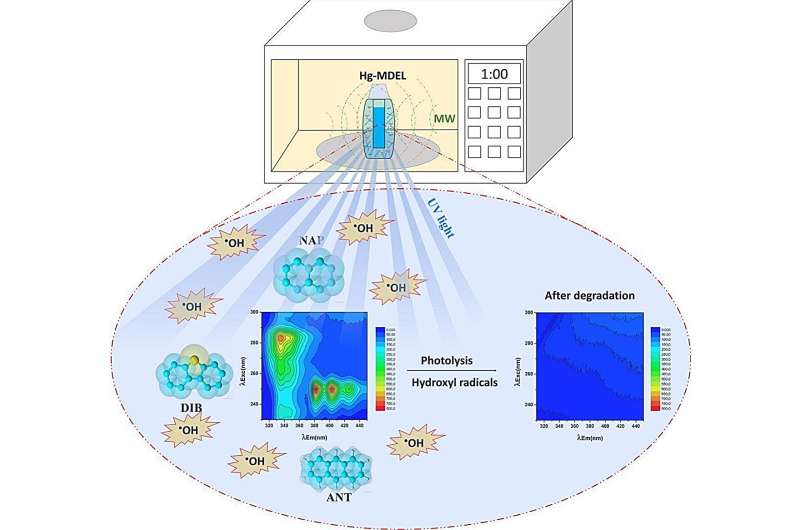This article has been reviewed according to Science X's editorial process and policies. Editors have highlighted the following attributes while ensuring the content's credibility:
fact-checked
trusted source
proofread
Researchers obtain promising results for control of pollutants in water

An article published in the journal Catalysis Communications describes a simple, efficient and sustainable approach to the degradation and quantitative monitoring of a mixture of polycyclic aromatic hydrocarbons (PAHs), emerging pollutants that contaminate various ecosystems, owing to oil and other fossil fuel spills and improper disposal of industrial waste.
Emerging pollutants are chemical compounds that have recently been identified as harmful to human health and the environment, but are not regularly monitored and cannot be removed by conventional wastewater treatment methods. Examples include bisphenol (used in certain types of plastic), some pesticides, and substances found in personal care products and medications.
In pursuit of solutions to this problem, researchers in Brazil affiliated with the Federal University of São Carlos (UFSCar), São Paulo State University (UNESP) and the Federal University of Paraíba (UFPB) prepared a mixture containing low levels of naphthalene, anthracene and dibenzothiophene in surface water, simulating the natural environment.
They used excitation-emission matrix (EEM) fluorescence spectroscopy as a higher-order method of analysis and calibration coupled with parallel factor analysis for data processing, whereby they separated the spectral components of the mixture in order to identify and quantify each pollutant, as well as other potential compounds present in natural water.
This methodology enabled each analysis to be completed in less than two minutes, without production of any residue or the need for more costly and sophisticated techniques, such as chromatography.
The mixture was then degraded using a photochemical system in which a lamp was activated by microwave radiation. The system degraded between 88% and 100% of the organic pollutants in only a minute. This high performance was associated with water photolysis that effectively generated hydroxyl radicals (oxidizing species capable of degrading organic pollutants at high speed).
According to Kelvin C. Araújo, first author of the article and a researcher at the Center for Development of Functional Materials (CDMF), a Research, Innovation and Dissemination Center (RIDC) hosted by UFSCar, one of the highlights of the study was the choice of PAH monitoring method. Chromatography, the usual method, limits progress in this type of research in many parts of the world because the equipment is expensive and the technique requires more sophisticated training, he explained.
In this study, the researchers used a spectrofluorometer, which is more affordable for many laboratories. The analysis is up to five times faster than in chromatography, and no residue is produced after the process. Moreover, Araújo noted, demand for more accessible methods was detected by the group, which has long studied water treatment using chromatography as its main analytical technique.
Photochemical system
Another significant aspect of the study was the use of a microwave-activated photochemical system to degrade the PAHs. According to Ailton Moreira, currently a researcher at UNESP Institute of Chemistry in Araraquara and a co-author of the article, efficiently and quickly degrading emerging pollutants without the use of catalysts is a major challenge.
"The challenge is even more daunting when you're working with mixtures of pollutants in natural water because of the many potential inhibitors of the degradation process, but the photochemical system performed outstandingly," Moreira said, adding that the same system had already proven effective in studies involving degradation of agricultural and pharmaceutical waste. Based on the findings described in the article, the photochemical system could be used on a far larger scale—in wastewater treatment plants, for example.
The authors confirm that both the analytical method and the degradation process will be the focus of future studies in different projects led by members of the group. Next steps will include application of these technologies at a wastewater treatment plant in Gavião Peixoto, a city in São Paulo state, to monitor and degrade emerging pollutants.
More information: Kelvin C. Araújo et al, Fast and efficient processes for oxidation and monitoring of polycyclic aromatic hydrocarbons in environmental matrices, Catalysis Communications (2023). DOI: 10.1016/j.catcom.2023.106834
Provided by FAPESP





















